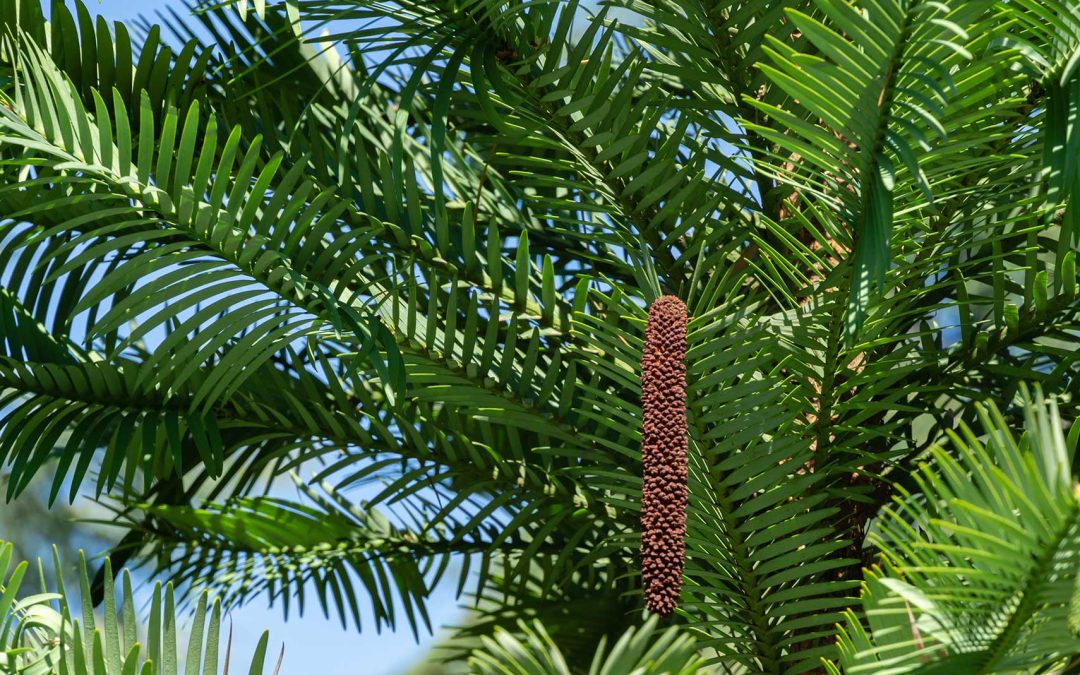Also known as living fossil trees, the following species are evidenced by fossil records. Many fossil trees and plants can be found at specialty nurseries throughout Southcentral BC and planted into coastal gardens and semi-arid regions throughout the Okanagan-Similkameen.
Wollemi Pine Tree
Recently discovered in 1994 in a rainforest region of Wollemi National Park in Australia, fossil records indicate they were common throughout Australia until 40 million years ago then declined. Recent fossils found in Tasmania are clocked at 2 million years old. In modern gardens, this species is proving to be adaptable and cold hardy, tolerating temperatures between -12 C to 45 C. Sydney’s Royal Botanical Gardens has now published information on how to grow Wollemi Pines from seed. Seedlings are slow growing and have proved to be vigorous, tolerating full sun to semi shaded outdoor plantings. Mature trees live for 500 to 1,000 years. It can take up to 25 years for them to reach a height of 20 feet, making them a popular choice for potted plants in conservatories and sunrooms.
Conservation status: Critically Endangered
Gingko Biloba – Maidenhair Tree

The Gingko, or Maidenhair Tree, grows over 12 meters (40 feet) tall and is popular as a shade tree for lawns and shadow gardens. Interestingly, the Gingko Tree is highly resilient to city pollution, having first appeared when CO2 levels were double what they are today. Fossils of this species have been found that date back 270 million years. In the fall, the male Gingkos turn a lovely golden colour before dropping leaves for the winter. Female trees are not as popular, as they produce an unpleasant smelling fruit. Plant your Gingko in full sun in a well watered, well drained location. This fossil tree is both insect and fungus resistant, and highly prized for its medicinal qualities as found in vitamin supplements across the world.
Conservation status: Endangered
Monkey Puzzle Tree

Native to central and southern Chile, this unusual evergreen is now endangered due to logging, forest fires and grazing practices. The Monkey Tree is popular as a garden tree for its bizarre reptilian branches and symmetrical appearance. This fossil species prefers temperature climates with high rainfall, and is cold hardy, tolerating temperatures to -20 C. Monkey Tree seeds are edible, and taste like pine nuts. Harvesting the seeds is easy since the cones drop to the ground where they can be gathered. Before planting a Monkey Puzzle Tree, be aware of a safety issue – their odd leaves are thick and scale-like with razor-sharp edges.
Conservation status: Endangered
Relatives: Hoop Pine, Norfolk Island Pine, and Bunya Pine
Tree Ferns

One of the most popular varieties is the Dicksonia Antarctica, prized as a slow growing species that can be kept inside in large containers. Dicksonia Tree Ferns are native to Australia and Tasmania, with fossil records dating back to the Jurassic period. They are cold hardy, and popular throughout the Pacific Northwest. Plant your fern in rich garden soil and protect them pre-frost with a thick layer of mulch. As ferns, they need to be kept moist and protected from hot afternoon sun.
If tree planting and care is in your task list this spring, contact us for a consultation or on-site visit for customized tree and landscaping services.
Tree Consultations and Management
Fruit Tree Pruning
Landscaping – planting and design
Certified Arborist Services
Utility Arborist Services
We always offer free estimates, senior’s discounts and repeat customer discounts to show our appreciation to local communities. Our business has grown exponentially over the years and we now offer experienced tree and landscaping services in several locations in Southwest BC. We look forward to serving you in 2021.
You may also be interested in: Endangered Tree Species in BC
Call Pine Valley Tree Service and Landscaping to talk with one of our dedicated tree specialists. We have over 40 years of experience serving the communities of southwest BC and work throughout the winter for hazardous tree removals, site preparations and utility arborist services.

